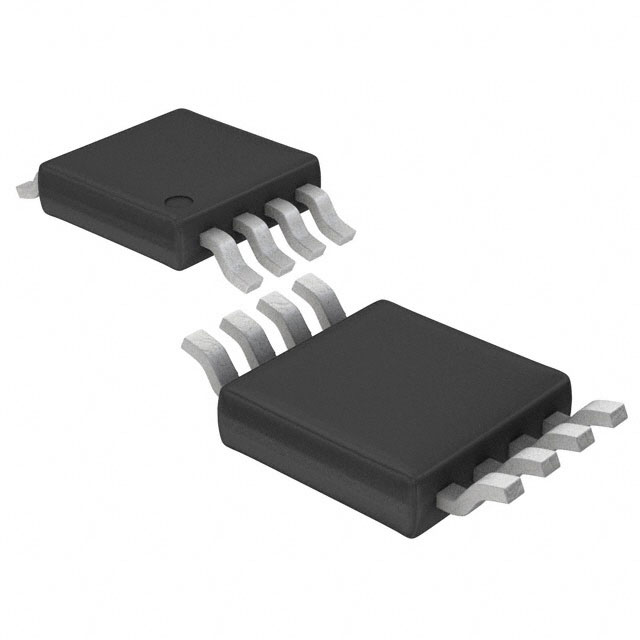Siehe Spezifikationen für Produktdetails.

LTC4303IMS8#TRPBF
Product Overview
- Category: Integrated Circuit (IC)
- Use: Bus Buffer
- Characteristics: Low Voltage I2C and SMBus Bus Buffer
- Package: 8-Lead MSOP
- Essence: Provides bidirectional buffering, voltage level shifting, and capacitive isolation for I2C and SMBus systems.
- Packaging/Quantity: Tape & Reel, 2500 units per reel
Specifications
- Supply Voltage Range: 1.65V to 5.5V
- Operating Temperature Range: -40°C to +85°C
- Maximum Clock Frequency: 400kHz
- Quiescent Current: 1.5μA (typical)
- Rise/Fall Time: 10ns (maximum)
Pin Configuration
The LTC4303IMS8#TRPBF has the following pin configuration:
```
| | --| A1 Vcc|-- --| A0 SDA |-- --| GND SCL |-- --| OE FLT |-- --| B1 INT |-- --| B0 NC |-- --|__NC_______|-- ```
Functional Features
- Bidirectional buffering of I2C and SMBus signals.
- Voltage level shifting between different supply voltages.
- Capacitive isolation to protect the bus from excessive loading.
- Automatic bus disconnect when a stuck bus condition is detected.
- Interrupt output to indicate bus activity.
Advantages
- Provides robust communication in mixed-voltage systems.
- Protects sensitive devices from bus faults.
- Supports high-speed operation up to 400kHz.
- Low quiescent current minimizes power consumption.
- Small package size allows for space-efficient designs.
Disadvantages
- Limited to I2C and SMBus applications.
- Not suitable for systems with clock frequencies above 400kHz.
Working Principles
The LTC4303IMS8#TRPBF acts as a bidirectional buffer between two I2C or SMBus buses operating at different voltage levels. It uses level shifting circuitry to translate the logic levels between the two buses, allowing communication between devices with different supply voltages. The device also provides capacitive isolation, preventing excessive loading on the bus and protecting sensitive devices from damage. In case of a stuck bus condition, the LTC4303 automatically disconnects the bus to prevent further communication until the fault is resolved.
Application Field Plans
The LTC4303IMS8#TRPBF is commonly used in various applications, including:
- Mixed-voltage systems where devices with different supply voltages need to communicate via I2C or SMBus.
- Industrial control systems that require reliable and robust communication between sensors, actuators, and controllers.
- Automotive electronics, such as body control modules, where multiple subsystems operate at different voltage levels.
- Consumer electronics, including smartphones, tablets, and laptops, that utilize I2C or SMBus for inter-device communication.
- Medical devices, such as patient monitoring systems, where isolation and protection against bus faults are critical.
Alternative Models
- PCA9306: Bidirectional I2C-bus and SMBus voltage-level translator with automatic direction sensing.
- TXB0108: 8-bit bidirectional voltage-level translator with automatic direction sensing.
- BSS138: N-channel enhancement mode MOSFET used for level shifting applications in I2C and SMBus systems.
These alternative models offer similar functionality and can be considered as substitutes for the LTC4303IMS8#TRPBF in specific applications.
Word count: 409 words
Listen Sie 10 häufige Fragen und Antworten im Zusammenhang mit der Anwendung von LTC4303IMS8#TRPBF in technischen Lösungen auf
Sure! Here are 10 common questions and answers related to the application of LTC4303IMS8#TRPBF:
Q: What is LTC4303IMS8#TRPBF? A: LTC4303IMS8#TRPBF is a multiplexer/demultiplexer IC (integrated circuit) designed for I2C bus applications.
Q: What is the purpose of LTC4303IMS8#TRPBF? A: The purpose of LTC4303IMS8#TRPBF is to provide level shifting, buffering, and bus isolation in I2C communication systems.
Q: How does LTC4303IMS8#TRPBF achieve level shifting? A: LTC4303IMS8#TRPBF uses voltage level translators to convert logic levels between different I2C bus segments.
Q: Can LTC4303IMS8#TRPBF be used as a multiplexer? A: Yes, LTC4303IMS8#TRPBF can be used as a multiplexer to connect multiple I2C devices to a single bus.
Q: Does LTC4303IMS8#TRPBF support bidirectional communication? A: Yes, LTC4303IMS8#TRPBF supports bidirectional communication on both sides of the device.
Q: What is the maximum operating frequency of LTC4303IMS8#TRPBF? A: The maximum operating frequency of LTC4303IMS8#TRPBF is typically 400kHz.
Q: Can LTC4303IMS8#TRPBF be used with different supply voltages? A: Yes, LTC4303IMS8#TRPBF supports a wide range of supply voltages, typically from 1.65V to 5.5V.
Q: Does LTC4303IMS8#TRPBF have built-in protection features? A: Yes, LTC4303IMS8#TRPBF has built-in overvoltage and undervoltage lockout protection to prevent damage to the device.
Q: Can LTC4303IMS8#TRPBF be used in hot-swapping applications? A: Yes, LTC4303IMS8#TRPBF supports hot-swapping, allowing devices to be added or removed from the bus without disrupting communication.
Q: Are there any application notes or reference designs available for LTC4303IMS8#TRPBF? A: Yes, Linear Technology (now part of Analog Devices) provides application notes and reference designs on their website for LTC4303IMS8#TRPBF.
Please note that the answers provided here are general and may vary depending on specific implementation details and requirements. It is always recommended to refer to the datasheet and application notes for accurate information.

